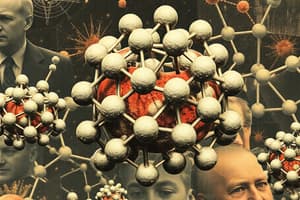Podcast
Questions and Answers
Which of the following shapes do fullerenes NOT typically take? (Select all that apply)
Which of the following shapes do fullerenes NOT typically take? (Select all that apply)
- Ellipsoids
- Hollow spheres
- Flat sheets (correct)
- Cylinders
What is the most famous fullerene, often referred to as C₆₀?
What is the most famous fullerene, often referred to as C₆₀?
- Carbon nanotube
- Pentafullerene
- Buckminsterfullerene (correct)
- Graphene
What happens to fullerene as the temperature is increased?
What happens to fullerene as the temperature is increased?
- It undergoes a phase change to graphene.
- It solidifies into diamond.
- It becomes a gas. (correct)
- It converts into C₇₀.
What type of bond connects the carbon atoms in fullerenes?
What type of bond connects the carbon atoms in fullerenes?
How does the structure of fullerenes contribute to a large number of isomers?
How does the structure of fullerenes contribute to a large number of isomers?
What type of materials are carbon nanotubes considered due to their properties?
What type of materials are carbon nanotubes considered due to their properties?
What structure do carbon nanotubes exhibit?
What structure do carbon nanotubes exhibit?
Which of these is NOT a characteristic feature of fullerenes?
Which of these is NOT a characteristic feature of fullerenes?
Which application is associated with the properties of fullerenes and carbon nanotubes?
Which application is associated with the properties of fullerenes and carbon nanotubes?
What type of molecular formation is found in fullerenes?
What type of molecular formation is found in fullerenes?
Flashcards are hidden until you start studying
Study Notes
Fullerenes Overview
- Fullerenes are carbon molecules that primarily form hollow structures, with common shapes including spheres, ellipsoids, and cylinders.
- Fullerenes are characterized by their unique carbon bonding, consisting of both single and double bonds between carbon atoms.
- The most renowned fullerene is Buckminsterfullerene (C₆₀), named after architect Buckminster Fuller for its resemblance to a geodesic dome.
Physical Properties and Behavior
- Fullerenes can undergo phase changes, particularly when heated, potentially converting into other forms like graphene or different fullerene species.
- As the temperature increases, fullerenes may transition into gaseous forms rather than solidifying into diamond.
Isomer Variability
- The existence of numerous isomers for fullerenes is attributed to their diverse shapes and bonding configurations, allowing each carbon atom to connect to four others.
Carbon Nanotubes
- Carbon nanotubes are a subcategory of fullerenes, distinguished by their cylindrical structure and exceptional physical properties.
- Due to their unique attributes, carbon nanotubes are classified as composite materials, often used to create high-strength materials.
Characteristics and Applications
- Fullerenes are stable, solely composed of carbon, and possess distinctive physical properties, but they do not typically contain metal atoms.
- Applications of fullerenes and carbon nanotubes range from high-strength materials to potential uses in pharmaceutical drugs, leveraging their unique properties for various industries.
Molecular Structure
- Fullerenes feature a molecular formation of fused rings rather than linear chains, cubic lattices, or graphite layers, emphasizing their complex geometry.
Studying That Suits You
Use AI to generate personalized quizzes and flashcards to suit your learning preferences.




